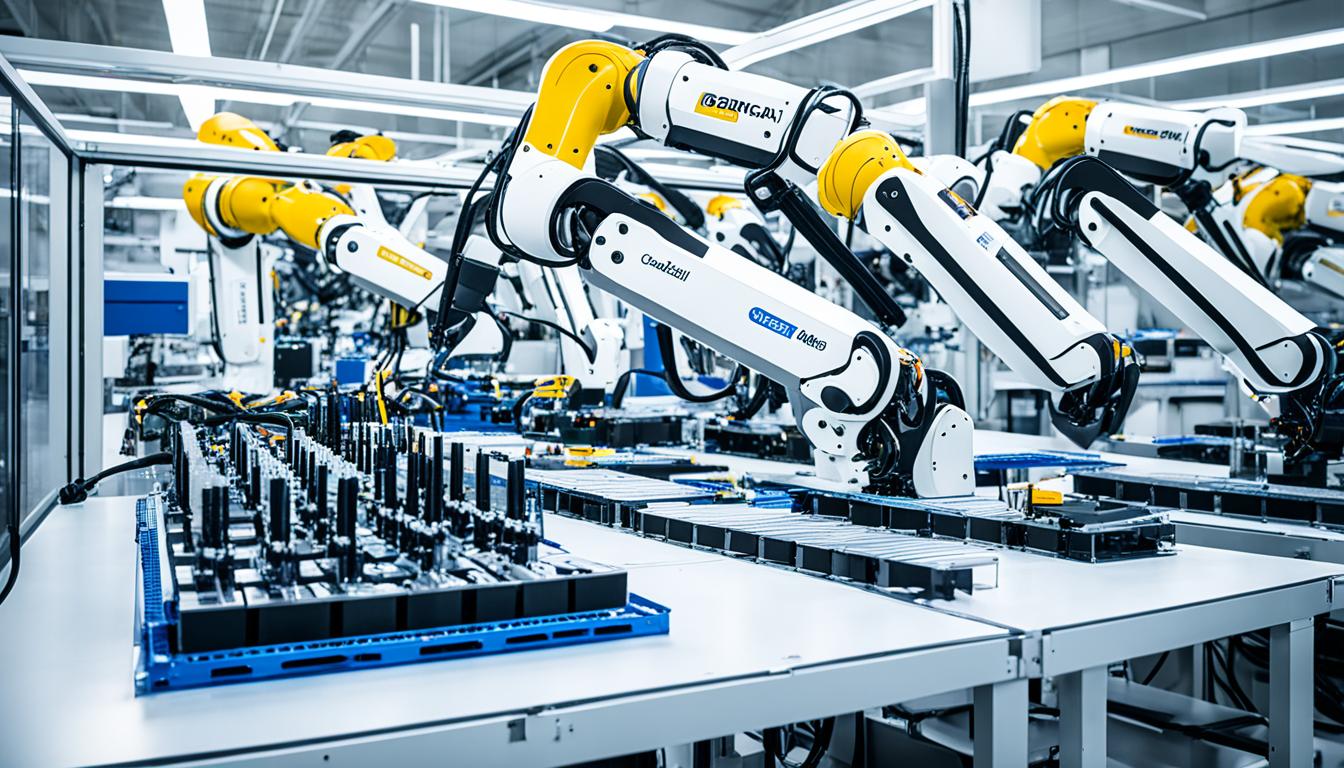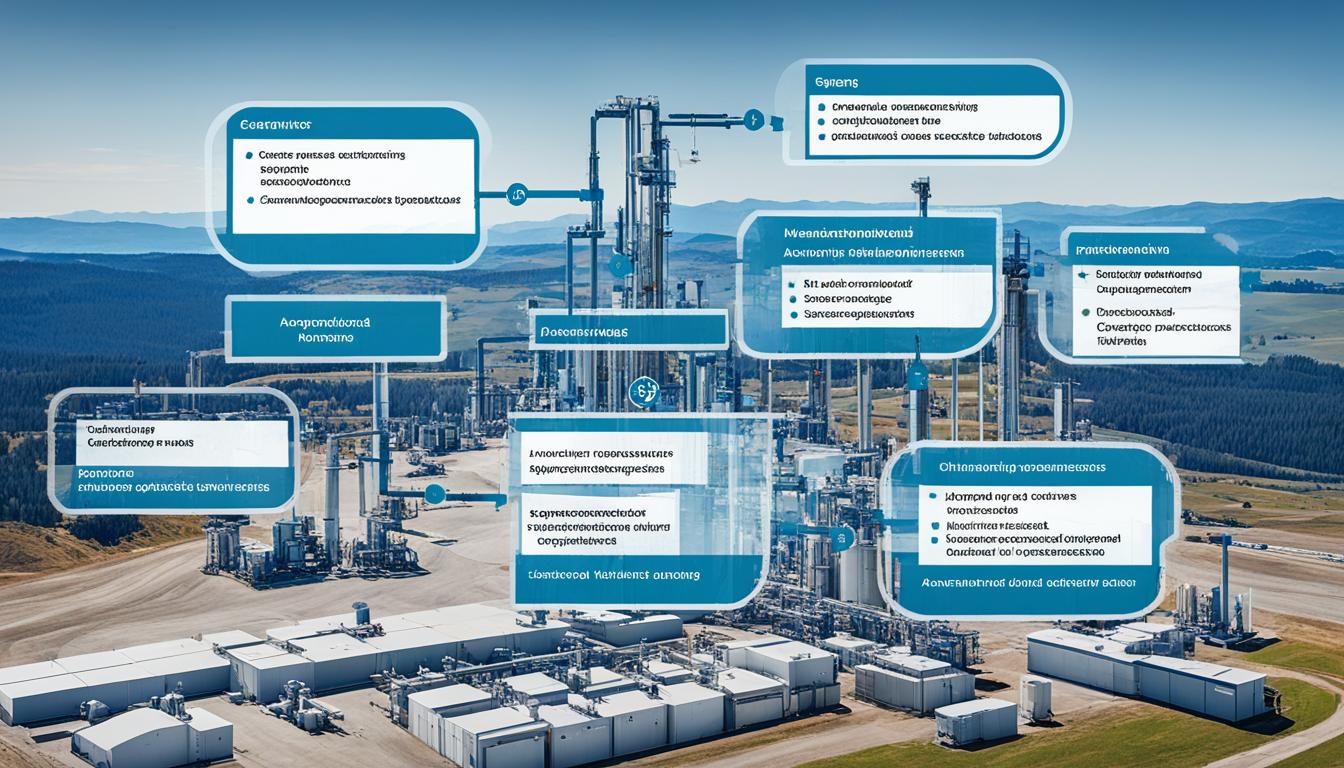Can automation truly optimize business efficiency and enhance the productivity of field teams? In today’s rapidly evolving business landscape, the answer is a resounding yes. The power of automation lies in its ability to automate repetitive and time-consuming tasks, freeing up valuable time and resources for businesses to focus on higher-value activities.
Automation streamlines operations by leveraging advanced technologies like artificial intelligence and machine learning, enabling businesses to make data-driven decisions and improve overall performance. But how exactly does automation enhance field team efficiency and drive business success? Let’s delve into the details and discover the transformative impact of automation.
Key Takeaways:
- Automation plays a crucial role in enhancing the efficiency of field teams in various industries.
- By automating repetitive tasks, businesses can streamline their operations and optimize their workflow.
- Automation saves time, improves productivity, reduces errors, and improves overall business efficiency.
- Advanced technologies like artificial intelligence and machine learning enable businesses to make data-driven decisions.
- Automation unlocks the potential for businesses to achieve higher levels of productivity, efficiency, and operational excellence.
Understanding Enterprise Automation
Enterprise automation refers to the integration of automation technologies into various processes and operations within an organization. It involves the use of software, robotics, and artificial intelligence to automate tasks, streamline workflows, and improve overall business efficiency.
Enterprise automation plays a crucial role in driving digital transformation by helping businesses optimize their operations, reduce costs, and improve customer experiences. It encompasses a range of business automation tools and solutions that cater to different needs and objectives.
By implementing enterprise automation, organizations can achieve:
- Efficient and streamlined processes
- Improved productivity and operational efficiency
- Reduced manual errors
- Better resource allocation
- Enhanced customer experiences
Whether through the automation of back-office tasks, supply chain management, customer relationship management, or other business processes, enterprise automation empowers organizations to optimize their operations, drive growth, and stay ahead in today’s rapidly evolving business landscape.
Exploring Levels of Automation: From Basic to Intelligent
Automation plays a crucial role in optimizing business processes and enhancing operational efficiency. It can be divided into different levels based on the complexity and capabilities of the automation technology used. Understanding these levels is essential for businesses looking to implement automation solutions that align with their specific needs and objectives.
Basic Automation: Streamlining Routine Tasks
Basic automation focuses on streamlining routine and repetitive tasks that do not require complex decision-making. These tasks often consume a significant amount of time and effort for employees. By automating these processes, businesses can free up valuable resources and improve efficiency.
Some examples of routine tasks that can be automated at the basic level include data entry, report generation, email responses, and file organization. By leveraging basic automation tools and software, businesses can eliminate human error, save time, and improve overall productivity.
Process Automation: Enhancing Multistep Workflows
Process automation takes automation to the next level by optimizing multistep workflows within an organization. It involves the integration of different systems and tools to streamline complex business processes and improve overall productivity.
Businesses can automate tasks such as order processing, inventory management, and customer support, which involve multiple steps and interactions. Process automation tools enable tasks automation, data synchronization, and real-time collaboration, resulting in improved efficiency, reduced errors, and faster turnaround times.
By automating multistep workflows, businesses can ensure consistency and standardization, leading to increased productivity and enhanced customer satisfaction.
Intelligent Automation: Integrating AI for Advanced Decision Making
Intelligent automation represents the highest level of automation and involves the integration of artificial intelligence (AI) technologies like machine learning and natural language processing.
Intelligent automation enables businesses to make data-driven decisions by analyzing vast amounts of data and extracting insights. It is particularly useful for tasks that require cognitive abilities, such as data analysis, forecasting, and anomaly detection.
By integrating AI technologies, intelligent automation empowers businesses to improve operational efficiency, optimize decision-making processes, and adapt to dynamic market conditions.
Intelligent automation is the future of automation, driving digital transformation and revolutionizing industries.
Integrating AI technologies in the automation process improves decision making, enhances efficiency, and ensures accurate analyses. It is clear that automation has several levels that cater to different needs and scenarios. Basic automation simplifies routine tasks, process automation streamlines multistep workflows, and intelligent automation combines AI and automation to achieve advanced decision making.
The Impact of Automation on Team Productivity and Efficiency
Automation has a significant impact on team productivity and efficiency. By automating repetitive and time-consuming tasks, businesses can free up valuable time for employees to focus on more critical and strategic activities. This not only improves team morale but also allows them to contribute more effectively to the overall success of the organization.
One of the key benefits of automation is the reduction in errors and the improvement in task accuracy. Automated processes are designed to follow predefined rules and guidelines, minimizing the risk of human error. By eliminating manual intervention, businesses can ensure consistent and reliable results, leading to improved productivity and customer satisfaction.
Workflow optimization is another advantage of automation. By streamlining workflows and eliminating bottlenecks, businesses can achieve greater efficiency and faster turnaround times. Automated workflows ensure that tasks are completed in a timely manner, without unnecessary delays or dependencies. This leads to improved operational efficiency and enables teams to meet deadlines more effectively.
Furthermore, automation helps teams adapt to changing business requirements and scale their operations accordingly. As businesses grow, automation provides the flexibility to handle increased workloads without increasing headcount. With automated processes in place, teams can handle higher volumes of tasks and achieve greater output, resulting in increased productivity and reduced operational costs.
Overall, automation plays a crucial role in enhancing team productivity and efficiency. By automating tasks and optimizing workflows, businesses can empower their teams to focus on high-value activities, improve task accuracy, streamline operations, and achieve higher levels of productivity. As technology continues to advance, businesses that embrace automation will have a competitive edge in a fast-paced and evolving business landscape.
Real-World Applications: Success Stories in Automation
Real-world examples and success stories showcase the powerful impact of automation in various industries. These success stories highlight how businesses have leveraged automation to streamline operations, improve productivity, and achieve significant business outcomes. Let’s explore some notable success stories:
Automating Task Management in Retail: The Carhartt Example
Carhartt, a renowned retail brand, implemented automation to streamline their task management processes. By automating routine tasks such as inventory management, order processing, and reporting, Carhartt achieved improved efficiency, reduced errors, and faster turnaround times. With automation handling these repetitive tasks, the retail team could focus on more strategic activities, including customer engagement and product innovation. This resulted in enhanced customer experiences and increased sales. The Carhartt example demonstrates the transformative power of automation in the retail industry and how it can revolutionize business operations.
Document Processing Improvements at Exavault
Exavault, a document management solution provider, implemented automation to improve their document processing efficiency. Through automation, Exavault automated tasks such as data extraction, document classification, and content validation. By reducing manual efforts and improving accuracy, automation streamlined their document processing workflows, leading to faster turnaround times and better customer service. The automation solution at Exavault exemplifies the power of automation in document-intensive industries and its ability to revolutionize business processes.
Digital Transformation at Heineken: A Brewing Success
Heineken, a leading global brewery, embarked on a digital transformation journey to optimize their brewing processes. By implementing intelligent automation solutions that integrated AI technologies like machine learning and predictive analytics, Heineken achieved real-time data analysis, improved forecasting accuracy, and optimized production schedules. This digital transformation success story at Heineken demonstrates how intelligent automation can revolutionize traditional industries and drive significant business improvements.
These real-world success stories emphasize the transformative potential of automation and serve as inspiration for businesses looking to implement automation solutions. By leveraging automation technologies, businesses can streamline operations, improve efficiency, and unlock new levels of productivity.
Artificial Intelligence and Machine Learning: The Pinnacle of Automation
Artificial intelligence (AI) and machine learning (ML) represent the pinnacle of automation technologies. These advanced technologies enable machines to learn, adapt, and make intelligent decisions based on data and patterns. With AI and ML automation, businesses can harness the power of cognitive automation, natural language processing, and predictive analytics to revolutionize industries.
The integration of AI and ML automation enables autonomous decision-making, advanced data analysis, and personalized customer experiences. By leveraging these technologies, businesses can improve operational efficiency, optimize workflows, and drive digital transformation. The ability of machines to learn and make intelligent decisions empowers organizations to enhance productivity, reduce errors, and deliver exceptional customer satisfaction.
AI and ML automation offer a range of benefits, including:
- Autonomous decision-making: AI and ML technology enable machines to analyze vast amounts of data, identify patterns, and make informed decisions without human intervention. This empowers businesses to make accurate and timely decisions based on data-driven insights.
- Advanced data analysis: By leveraging AI and ML algorithms, businesses can extract valuable insights from large datasets. These insights can help in identifying trends, forecasting future outcomes, and optimizing business processes.
- Personalized customer experiences: AI and ML automation enable businesses to provide personalized recommendations, tailored marketing campaigns, and improved customer service. By analyzing customer data, businesses can deliver relevant and timely experiences that enhance customer satisfaction and loyalty.
As AI and ML automation continue to evolve, businesses can expect even more advanced capabilities, such as natural language processing, computer vision, and deep learning. These technologies will further enhance the automation landscape and open up possibilities for innovation and growth. Embracing AI and ML automation is essential for businesses looking to stay competitive in the digital age and unlock the full potential of automation.
Automation Tools and Solutions: Enhancing Field Operations
Automation tools and solutions play a crucial role in enhancing field operations in various industries. These tools are specifically designed to streamline workflows, automate repetitive tasks, and optimize business processes. Examples of automation tools include AIOps for streamlining IT operations, decision management systems using machine learning, and process mapping tools for operational excellence. Automation tools enable businesses to improve efficiency, reduce errors, and achieve higher levels of productivity. They are essential in enhancing field operations and driving business success.
AIOps: Streamlining IT Operations
AIOps (Artificial Intelligence for IT Operations) is a technology that combines artificial intelligence and machine learning to streamline IT operations. AIOps automates tasks like monitoring, event correlation, incident management, and performance analysis. By leveraging AI algorithms, AIOps can analyze vast amounts of data, identify patterns, and provide actionable insights to IT teams. This enables faster problem resolution, proactive incident management, and improved overall IT service management. AIOps is instrumental in optimizing IT operations and driving business efficiency.
Decision Management with Machine Learning
Decision management systems powered by machine learning enable automated decision-making processes within organizations. These systems use machine learning algorithms to analyze data, identify patterns, and make intelligent decisions based on predefined rules. By automating decision-making processes, businesses can improve accuracy, reduce bias, and optimize resource allocation. Decision management with machine learning is beneficial in areas like customer segmentation, risk assessment, and supply chain optimization. It empowers organizations to make data-driven decisions and achieve better business outcomes.
Process Mapping for Operational Excellence
Process mapping is a critical tool for achieving operational excellence through automation. It involves visually representing business processes, identifying bottlenecks, and optimizing workflows for improved efficiency. Process mapping enables businesses to identify areas of improvement, streamline processes, and eliminate inefficiencies. By mapping out processes and automating them, organizations can achieve operational excellence, streamline operations, and drive business success.
| Automation Tool | Description |
|---|---|
| AIOps | Combines AI and machine learning to streamline IT operations, automate monitoring and incident management tasks. |
| Decision Management with Machine Learning | Enables automated decision-making by using machine learning algorithms to analyze data and make intelligent decisions. |
| Process Mapping | Visual representation of business processes to identify bottlenecks and optimize workflows for operational excellence. |
Empowering the Workforce with Robotic Process Automation
Robotic Process Automation (RPA) is revolutionizing the way businesses operate by empowering the workforce with automation tools. RPA software bots are designed to mimic human interactions with computer systems and perform repetitive and rule-based tasks. These tasks can range from data entry and form filling to data extraction and analysis. By automating these tasks, RPA enables employees to focus on more strategic and value-added activities, improving their productivity and job satisfaction.
RPA offers several benefits that empower the workforce and enhance overall business performance. Firstly, by automating repetitive tasks, RPA reduces the risk of errors and improves the accuracy of data processing. This not only saves time but also ensures high-quality output, boosting operational efficiency and customer satisfaction.
Furthermore, RPA frees up valuable time for employees to engage in more creative and problem-solving activities. Instead of spending hours on monotonous tasks, they can dedicate their time and energy to innovation, critical thinking, and customer interactions. This leads to better business outcomes, increased employee engagement, and a more fulfilling work environment.
RPA tools provide employees with the means to automate their own tasks, empowering them to take ownership of their work processes and improve their own efficiency. With user-friendly interfaces and intuitive automation workflows, employees can easily create and deploy automation solutions without extensive technical knowledge. This democratization of automation allows employees to optimize their own workflows, tailor automation to their specific needs, and achieve greater levels of autonomy in their work.
Ultimately, the empowerment of the workforce through RPA enables businesses to unlock their full potential. By leveraging automation tools, employees become catalysts for innovation and efficiency improvement. With repetitive and manual tasks automated, they can dedicate their time to activities that require critical thinking, creativity, and personalized customer interactions, driving business success and growth.
In conclusion, Robotic Process Automation (RPA) empowers the workforce by automating repetitive tasks, freeing up time for strategic activities, and enhancing overall productivity. By leveraging automation tools, businesses can create a more efficient and engaged workforce, driving innovation and achieving better business outcomes.
Trends and Future Directions in Automation Technology
The field of automation technology is continuously evolving, with several trends shaping its future. These trends are driving innovation and revolutionizing industries, offering new possibilities for businesses to optimize their operations and achieve greater efficiency. In this section, we will explore three key trends that are leading the way in automation technology: hyperautomation, sustainable IT practices, and the low-code/no-code revolution.
Hyperautomation: Merging Multiple Automation Technologies
Hyperautomation is a prominent trend in automation technology that involves the integration of multiple automation technologies to achieve end-to-end automation. By combining robotic process automation (RPA), artificial intelligence (AI), machine learning (ML), and workflow automation, businesses can automate complex and interconnected tasks and processes. Hyperautomation empowers organizations to achieve higher levels of operational efficiency, improve decision-making processes, and deliver enhanced customer experiences. This trend represents the future of automation, driving digital transformation and enabling businesses to stay competitive in a rapidly evolving landscape.
Sustainable IT: Green Automation Practices
Sustainability in automation is another significant trend that focuses on adopting green practices and minimizing the environmental impact of automation solutions. Businesses are increasingly recognizing the importance of reducing their carbon footprint and implementing eco-friendly practices in their automation processes. This involves using energy-efficient hardware, optimizing resource utilization, and implementing sustainable processes. By incorporating green automation practices, businesses can contribute to environmental sustainability while achieving their automation goals. Sustainable IT practices in automation are becoming essential as businesses strive for responsible and sustainable growth.
Low-code/No-code Revolution: Empowering Non-technical Users
The low-code/no-code revolution is empowering non-technical users to create and deploy automation solutions without the need for extensive coding knowledge. Low-code platforms provide visual interfaces and drag-and-drop functionality, enabling users to build applications and automate processes with ease. No-code platforms take it a step further by allowing users to create automation solutions without any coding requirement at all. This revolution democratizes automation, empowering non-technical users and citizen developers to contribute their expertise in automating tasks and processes. The low-code/no-code revolution opens up new possibilities for innovation, drives business agility, and enhances collaboration between technical and non-technical teams.
Automation Professionals: Unsung Heroes of Technological Advancement
Automation professionals are the true champions of technological advancement and innovation in businesses. These experts possess the knowledge and skills to design, develop, and implement automation solutions that optimize workflows, improve efficiency, and achieve business objectives.
Automation professionals encompass a wide range of roles, including developers, engineers, data scientists, and consultants, who specialize in automation technologies. They are the unsung heroes behind the scenes, utilizing their expertise and dedication to leverage automation for business success.
By harnessing automation technologies, these professionals drive the integration of cutting-edge automation tools and solutions into various industries. They ensure that businesses can streamline operations, eliminate bottlenecks, and optimize processes, all leading to improved efficiency and productivity.
Whether it’s developing custom software applications, integrating machine learning algorithms, or implementing robotic process automation, these professionals play a crucial role in enabling businesses to harness the full potential of automation.
Through their deep understanding of automation technologies, these experts empower businesses to stay ahead of the competition. They constantly seek innovative ways to leverage automation for process optimization, cost reduction, and enhanced customer experiences.
Automation professionals are the driving force behind businesses’ ability to adapt to technological advancements and the ever-changing digital landscape. By collaborating with cross-functional teams and leveraging their expertise, they pave the way for business growth and success in the era of automation.
It is crucial for businesses to recognize the invaluable contributions of automation professionals and provide them with the support and resources they need to continue pushing the boundaries of technological advancement. By doing so, businesses can unlock the full potential of automation and reap its countless benefits.
Conclusion
In conclusion, automation is a game-changer for enhancing field team efficiency and business productivity. By embracing automation technologies and solutions, businesses can optimize their operations, streamline workflows, and achieve higher levels of efficiency. The benefits of automation are numerous, including reduced errors, improved productivity, and advanced decision-making capabilities.
The future of automation looks promising, with trends like hyperautomation and sustainability driving its evolution. Hyperautomation, which combines various automation technologies, enables end-to-end automation and empowers businesses with optimized workflows and enhanced customer experiences. Additionally, sustainability in automation emphasizes eco-friendly practices to minimize the environmental impact of automation solutions, contributing to responsible and sustainable growth.
As businesses continue to adopt automation, they empower their workforce, enabling employees to focus on strategic tasks and value-added activities. Automation professionals, the unsung heroes behind these advancements, play a crucial role in driving technological innovation and leveraging automation for business success.
In the highly competitive business landscape, automation enables businesses to achieve operational excellence, improve business outcomes, and stay ahead of the curve. By harnessing the power of automation, businesses can unlock their full potential, drive efficiency, and pave the way for future growth and success.
FAQ
What is the role of automation in enhancing field team efficiency?
Automation plays a crucial role in enhancing the efficiency of field teams by automating repetitive and time-consuming tasks, streamlining operations, and optimizing workflows. This saves time, improves productivity, and allows field team members to focus on higher-value activities.
What is enterprise automation?
Enterprise automation refers to the integration of automation technologies into various processes and operations within an organization. It utilizes software, robotics, and artificial intelligence to automate tasks, streamline workflows, and improve overall business efficiency.
What are the different levels of automation?
Automation can be classified into different levels: basic automation, which streamlines routine tasks; process automation, which enhances multistep workflows; and intelligent automation, which integrates AI for advanced decision-making.
How does basic automation improve business efficiency?
Basic automation involves the automation of routine and repetitive tasks, such as data entry and email responses. By automating these tasks, businesses can save time, reduce errors, and improve overall efficiency.
How does process automation optimize business productivity?
Process automation focuses on automating and optimizing multistep workflows, such as order processing and customer support. It streamlines complex processes, improves collaboration, and reduces errors, resulting in increased productivity and customer satisfaction.
What is intelligent automation?
Intelligent automation combines automation technologies with artificial intelligence, such as machine learning and natural language processing. It allows for advanced data analysis and decision-making, empowering businesses to make data-driven decisions and improve operational efficiency.
How does automation impact team productivity and efficiency?
Automation frees up valuable time for employees by automating repetitive tasks, reduces errors, and streamlines workflows. This improves team productivity, enables faster turnaround times, and allows employees to focus on more critical and strategic activities.
Can you provide real-world examples of automation success stories?
Sure! Carhartt implemented automation to streamline task management, resulting in improved efficiency and customer experiences. Exavault improved document processing efficiency through automation, enabling faster turnaround times. Heineken achieved digital transformation by implementing intelligent automation, optimizing brewing processes.
What is the role of artificial intelligence and machine learning in automation?
Artificial intelligence and machine learning enable advanced automation capabilities, such as cognitive automation, intelligent decision-making, and data analysis. They empower businesses to leverage automation for improved efficiency, personalized experiences, and better business outcomes.
What are some essential automation tools and solutions for field operations?
AIOps streamlines IT operations, decision management systems enable automated decision-making, and process mapping tools optimize workflows. These automation tools enhance field operations, improve efficiency, and drive business success.
How does robotic process automation empower the workforce?
Robotic process automation automates repetitive and rule-based tasks, boosting employee productivity, reducing errors, and freeing up time for more strategic activities. RPA empowers employees to focus on creativity, problem-solving, and customer interactions.
What are the trends and future directions in automation technology?
Hyperautomation integrates multiple automation technologies for end-to-end automation, sustainability in automation focuses on green practices, and the low-code/no-code revolution empowers non-technical users to create automation solutions. These trends shape the future of automation and its potential to revolutionize industries.
What is the role of automation professionals in driving technological advancement?
Automation professionals, including developers, engineers, and data scientists, design, develop, and implement automation solutions to optimize workflows and improve business efficiency. They are instrumental in leveraging the full potential of automation and driving technological advancement.





